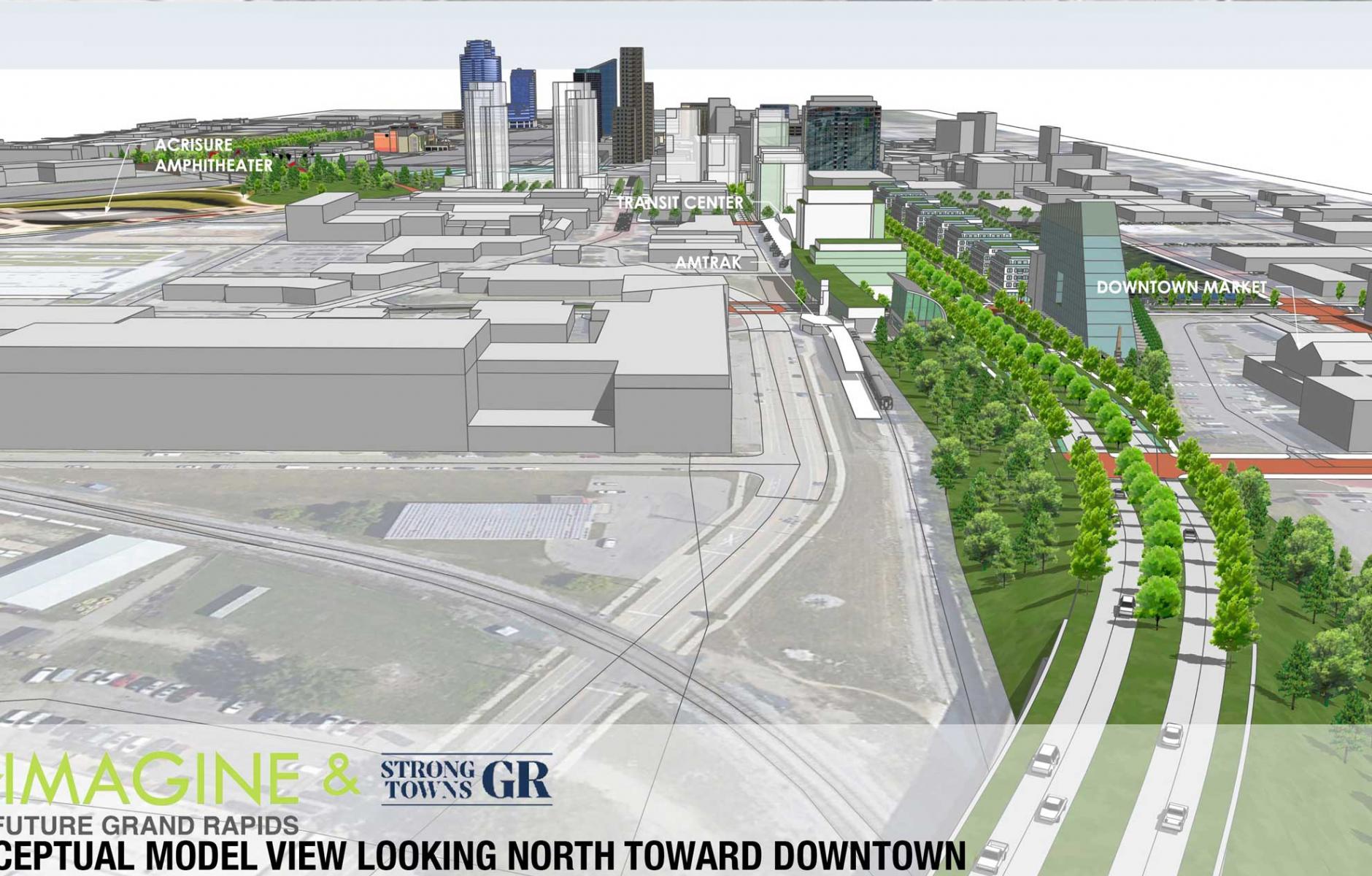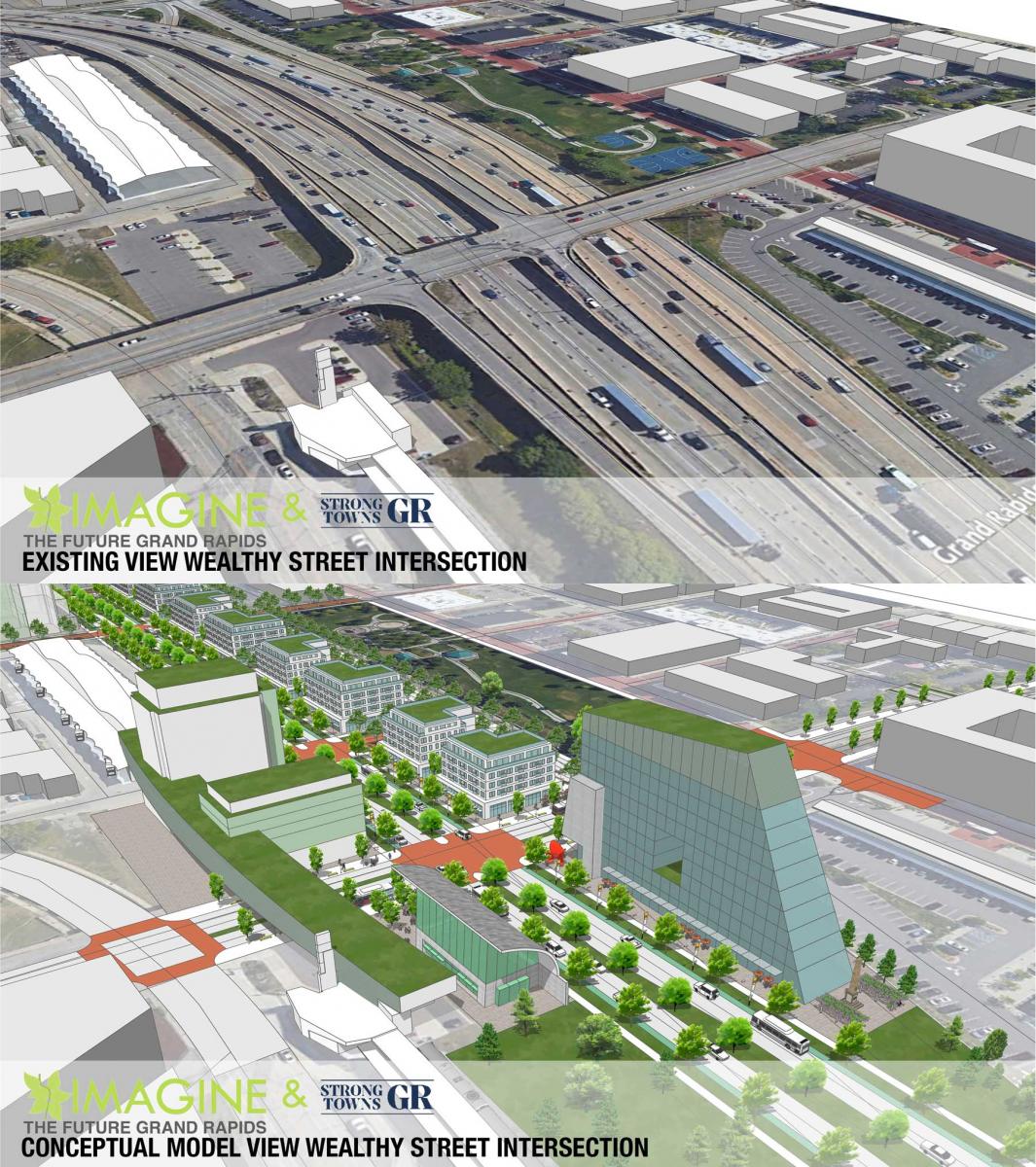
Stretching the imagination of a community’s highway-to-boulevard dreams
When people are forced to live for generations with destructive infrastructure, like an urban highway, they tend to restructure their lives to accommodate it and “work around it,” making it difficult to imagine that any other alternative will work. IMAGINE: The Future Grand Rapids is building a strong, broad base of grassroots support from affected communities, and from healthcare, environmental, social justice, and urbanism advocacy groups to replace US-131 in Grand Rapids, Michigan, with a green, low-speed boulevard and reconnected street grid.
US-131 was built through, and adjacent to, previously red-lined neighborhoods, displacing about 4,000 residents, including people of color, immigrants, working class, and socioeconomically challenged citizens. Business interests were prioritized, and affected residents were not consulted in the process. These communities have faced the brunt of the negative impacts of the highway on their health, quality of life, and property since it was completed.
The Michigan Department of Transportation (MDOT) has identified the segment of US-131 between 28th Street and Wealthy Street in downtown Grand Rapids as a priority zone to be analyzed in a PEL study. This segment has the highest traffic volumes in the area, aging pavement and bridges, closely spaced interchanges, and safety concerns. IMAGINE: The Future Grand Rapids is advocating for an Alternatives Study that centers the needs and concerns of residents, instead of MDOT’s preconceived notions about traffic.
The local campaign has created a variety of assets to inspire the community to look beyond highway expansion and envision the kind of community they might like to see. They have developed a detailed “master” document and prepared a “vision” document illustrating a potential green, low-speed boulevard with plans, aerial views, and details, and how it can benefit the community. They have also developed a large-scale 3D model of much of downtown Grand Rapids and the affected communities, illustrating a possible vision for what the future of US-131 could look like as a boulevard.

IMAGINE: The Future Grand Rapids has also identified that by diverting through traffic around the city on a pre-existing bypass, traffic into and out of the city can be reduced by 40%. This green low-speed boulevard will also reduce noise and air pollution, provide better health outcomes, create safer streets, allow neighborhoods to be reconnected, and contribute to local prosperity. The boulevard will be more conducive to supporting alternative transportation modes, reducing dependence on automobiles, and making alternative modes more feasible by increasing ridership.
Converting a highway to a boulevard has the benefits of reducing harmful air and noise pollutants, lessening spillover traffic from highways and reducing vehicle crashes. By taking back land from the highway, Grand Rapids can create space for new downtown commercial development, affordable housing, long-term jobs, public parks, and open space while reducing heat island effects, bettering street grid connections, increasing mobility options, and creating safer, more walkable communities.
These designs and beneficial impacts described aim to inspire stakeholders to imagine alternatives beyond highway expansion and to encourage them to imagine the possibility of something other than an expanded highway. The neighborhoods and their supporters must have a clear, community-centered vision before entering into discussions with MDOT to ensure that their needs are the focus of any transportation discussion.
IMAGINE: The Future Grand Rapids is in the early stages of creating a coalition and has been involved in many meetings, presentations, discussions, and workshops with the impacted communities and supporters. By empowering community members from the start and centering local priorities, highways to boulevards campaigns offer a path forward for communities to repair, rebuild, and reknit instead of ‘working around it.’
Learn more about their work and connect with the group at mohillmich@att.net.




